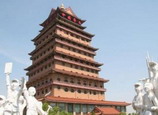
BEIJING, May 24 (Xinhua) -- With China's state-owned enterprises (SOEs) posting growth of just 5.3 percent from January to April this year, prospects for the SOEs' profitability in 2013 remain poor, analysts said.
The SOEs saw their total profit growth slow to 5.3 percent year on year to reach 689.13 billion yuan (111.32 billion U.S. dollars) in the first four months, according to the Ministry of Finance (MOF).
The growth rate was lower than the 7.7-percent increase recorded for the first quarter and average growth of 5.8 percent in 2012, official data showed.
The SOEs lost their position as the country's most profitable sector in 2012, when China COSCO Holdings Co., the country's largest shipping company, lost 9.56 billion yuan after a deficit of 10.45 billion yuan for 2011.
Overcapacity, inefficient cost control and slow industrial upgrading can be blamed for the slowdown, according to Li Jin, a senior researcher with the China Enterprise Research Institute.
From January to April 2013, the total profits of locally-administered SOEs suffered a decline of 14.7 percent to 152.89 billion yuan, according to the MOF.
For centrally-administered SOEs, the situation is also difficult. They generated profits of 536.24 billion yuan in the first four months of 2013, a 12.8 percent increase year on year, but down from 16.5 percent compared with the figure from January to March.
"The SOEs that recorded profit declines are mainly in the traditional industries instead of high-tech or emerging industries. They rely largely on expanding investment to boost growth and are easily affected by changes in the economic cycle," said Li.
The MOF data showed that SOEs in the power, electronics and housing construction sectors reported relatively fast profit growth, while those in the transportation, non-ferrous metal, coal, chemical and construction material sectors saw profit declines.
Li said steelmakers were too aggressive in increasing their size during better times and still lack the capability to negotiate iron ore prices, leading to worsening overcapacity.
In addition, SOEs have enormous expense budgets and poor management, which means some SOEs are footing the bill for inadequate performance, said Wen Zongyu, director of the State-owned Research Institute for Fiscal Science under the MOF.
Figures from the MOF revealed that the operating costs for central SOEs increased 8.8 percent year on year from January to April, while those of local SOEs rose 13.4 percent.
Exorbitant spending on receptions by some listed companies has been fiercely criticized, with the 10 biggest reception spenders, mostly SOEs, spending a combined total of 2.9 billion yuan on receptions last year.
China Railway Construction Co., Ltd. topped the list with total spending of 837 million yuan, equivalent to about 10 percent of the company's profits last year.
"High expenses may be a source of corruption among high-level management," said Sun Lijian, a professor at Fudan University.
A manufacturing contraction that followed the slow growth of Chinese economy in the first quarter and concerns of a possible financial meltdown have all added to the uncertainty surrounding the SOES' profitability, Wen said.
He said SOEs should move more quickly to eliminate excess production capacity, increase the added value of their products and improve management in order to lower their costs.
"Most importantly, SOEs should find the drive to continue reforms and industrial upgrades to prevent themselves from sailing into stormy waters," Wen said.
















 Couple say 'I do' after 35-year wait
Couple say 'I do' after 35-year wait


![]()
